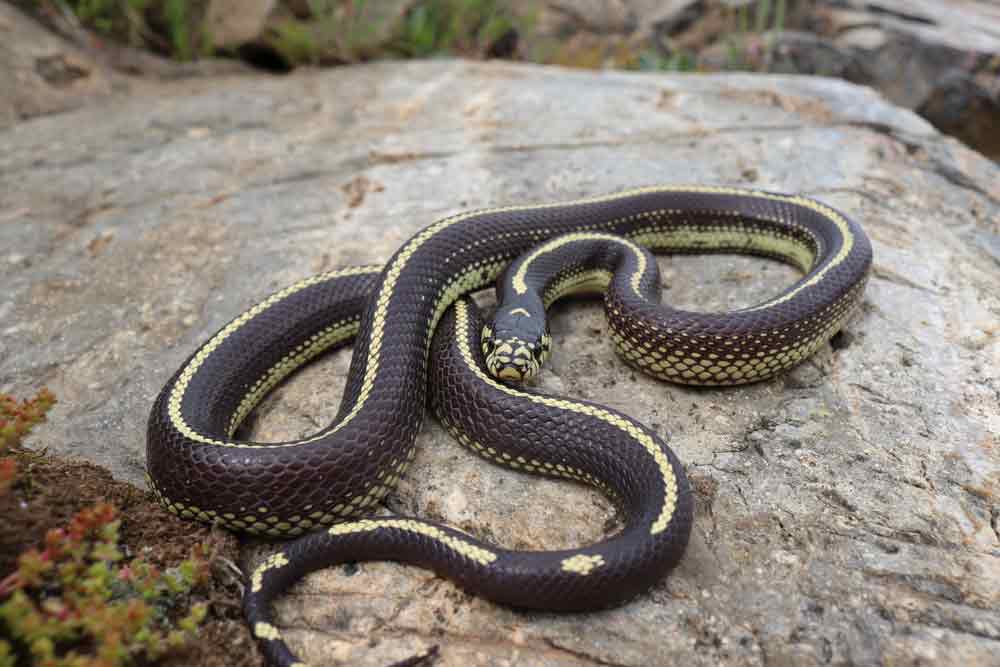The California kingsnake is one of the best choices among any level of reptile keeper. They are widely available, and for those looking for something different, are available in a variety of morphs and color patterns.
Kingsnakes are one of the most popular snake species amongst reptile keepers, and of the 45 recognized subspecies, the California kingsnake (Lampropeltis getula californiae) may be the most popular of all kingsnakes. These New World colubrids include milksnakes, and in addition to eating rodents, lizards, and birds, are known to eat other snakes, including venomous snakes such as rattlesnakes, copperheads and cottonmouths. This is known as Ophiophagy. Kingsnakes are found throughout much of the United States. The California kingsnake can be found throughout California, and into Arizona, Oregon, Nevada and down into Baja California.
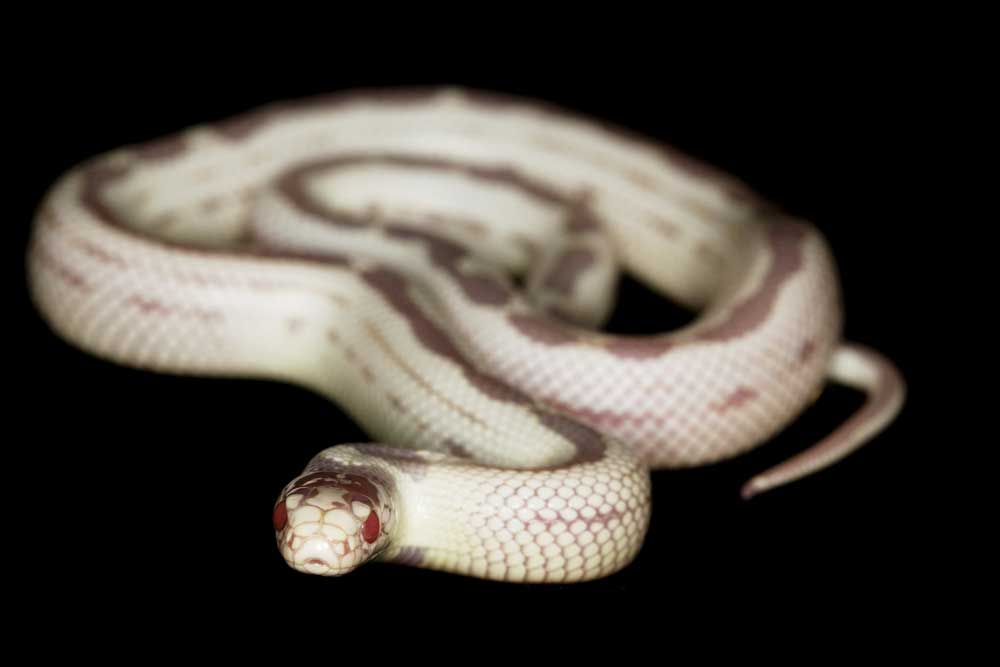
A reversed stripe albino California kingsnake. Photo by Fivespots/Shutterstock
The California kingsnake is native not only to California, but can be found in Arizona, Oregon, Utah, Nevada, and into Mexico. They inhabit a variety of ecosystems, ranging from the wetlands of Southern California to the high elevation mountains of many of these states. They are found in the wild with a variety of colorations and morphs and breed with both the desert kingsnake (Lampropeltis splendida and native to Arizona, Texas and New Mexico) and the Mexican black kingsnake (Lampropeltis getula nigrita and native to the Sonoran Desert of Mexico, Northwestern Sinaloa and into Arizona), further diversifying the colors and patterns.
California Kingsnake Care, Breeding and Morphs
Image of California Kingsnake Trying to Eat an Alligator Lizard Goes Viral
All Hail The California Kingsnake
The California kingsnake is widely captive-bred, available at virtually every reptile store and even the big box pet stores, and they come in a variety of color patterns, or morphs. They don’t get very large, can easily live more than 15 years and the care for kingsnakes is relatively straightforward. While this snake is almost always on the list of one of the most popular snakes with those new to snake keeping, one thing that they are famous for is their attitude. They are not timid like a cornsnake. Some individuals can be a bit bitey. I acquired my albino California kingsnake from Bob Applegate back in 2012, and she still bites on occasion, and for no apparent reason. Other than this, she is a great and inquisitive snake.
Snowy is not my first California kingsnake. I acquired my first California kingsnake a long time ago as a hatchling. I was told to keep it in a 10-gallon aquarium with a lid, some Astroturf and a bowl of water. I was to feed it pinky mice once a week until it got larger, then mice and that was it. There was not a lot of care information back then. At about six months of age, the snake escaped and I never was able to find it. Which brings me to my first tip in keeping this species. Ensure your enclosure is secure.
Ideal Enclosure For Your California Kingsnake
Enclosures for California kingsnakes don’t have to be overly complicated. But they should be good size. A 40-gallon equivalent, escape-proof terrarium (36”L x 18”W x 18”H) is the ideal size for an adult California kingsnake of about 4 to 5 feet in length. This size makes it easy to create a thermal gradient with a warm side and a cool side. It is also enough space for the snake to move comfortably about. Ensure that the lid or top is escape proof. Larger snakes will need larger enclosures. Hatchlings can be kept in 20- or 30- gallon enclosures until they grow to full size. Some of the reptile product manufacturers have all in one solutions using 20- and 30- gallon equivalent enclosures. These are great kits to get you started as they have nearly everything you need for your kingsnake. Most of the time all that you need to add is a quality thermostat. Because the California kingsnake and all other kingsnakes are Ophiophagus, they must be housed alone. Aspen shavings are a good substrate for this species. The shavings enable your snake to burrow, which it will, and cleaning up after your snake is easy, as aspen will clump around the urates, making pickup simple.
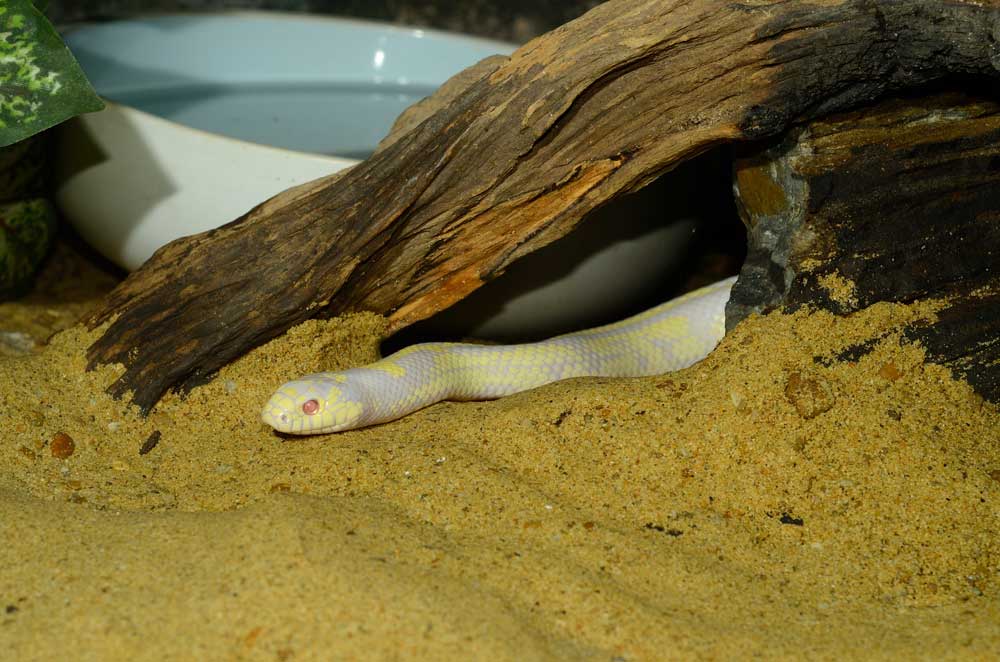
ensure your enclosure has adequate hiding places. Photo by Cowboy54/Shutterstock
The Importance of Tree Branches And Hides For Your California Kingsnake
Place tree branches or driftwood in strategic locations within the enclosure. These can be cork barks or mopani woods that you can purchase from your local reptile store, or they can be driftwood found on beaches or other bodies of water. You can sanitize these by placing them in the oven at low heat for a few hours. If the collected branches or wood are too big, submerge them under water for a few days and then fully sun dry them before placing them in the enclosure. The inclusion of these climbing materials will give your kingsnake the option to get up off the floor of the enclosure and higher up in the enclosure.
These natural accessories provide plenty of enrichment for your snake. When I added some big climbing branches to Snowy’s enclosure, she stopped pacing back and forth in the front of her enclosure and now moves about the branches in her enclosure. Her new behavior with the added enrichment is like night and day. Hides and caves are an important element to your kingsnake’s well-being. These mini hotels enable your snake to get away from prying eyes when it wants to, and doubles as a safety measure to the snake as it is enclosed at the top, and with some hides, on three sides. I have both a hide and a cave in Snowy’s enclosure and I found that after a feeding, she retreats to the cave for several days. She uses the hide as a perch. I’ve not yet seen her inside the hide.
California Kingsnake Heating Requirements
There are several ways to heat your kingsnake’s enclosure. You can use an undertank heat pad combined with a thermostat, a ceramic heat emitter, or a basking spot lamp on the screen mesh top. It depends largely on the enclosure. The UTH pad is ideal in that the snake will receive constant belly heat when it so chooses. Just ensure the heat can permeate through the bottom of your enclosure. If your substrate is thicker and the enclosure bottom is also thick, the heat may not be able to penetrate and get to the snake. Basking spot lamps or a ceramic heat emitter would be a better solution in this regard. Place the heat source on one side of the enclosure. Place a hide on the warm side of the enclosure, as well as on the cool side of the enclosure. This will ensure that your kingsnake can move between the two and thermoregulate. Maintain a temperature of about 85 degrees Fahrenheit (29.4 degrees Celsius) on the warm side of the enclosure and into the 70s on the cool end. Moving the heating element around will ensure you can get the ideal temperature range in the enclosure. Buy a quality thermometer and read it daily to ensure the temperatures are within range.
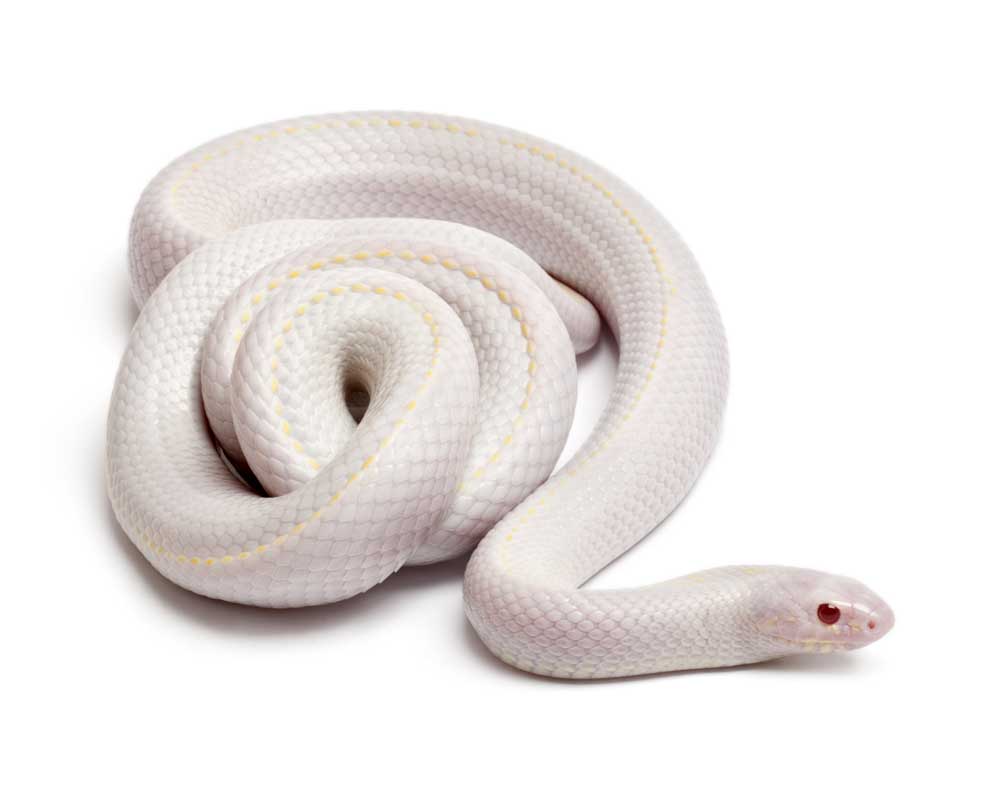
A snow color phase California kingsnake. Photo by Eric Isselee/Shutterstock
Heat is probably the most important element that your kingsnake needs to thrive. Keep in mind where you live when supplying heat for your snake, as your location will require more or less heat than others. For example, I live in Southern California, where the winters get into the low 50s and the summers can get into the 90s. I use a ceramic heat emitter as the heat source for my kingsnake nine months out of the year. From June to September, I don’t provide any heat source because my house faces West and my reptile room gets plenty of heat during those summer months. When my reptile room gets too hot, all my snakes find their way into their water bowls. This is an important indicator that the room is too hot. Before I had air conditioning, I placed ice cubes in the water bowl. This is still a good solution, though you have to monitor the temperatures during days of extreme heat. As fall rolls around, the ceramic heat emitter is turned on again. Heat is also imperative for digestion.
California Kingsnake Water Bowl
Water is an important part of your snake’s health. Make sure your kingsnake has fresh water at all times. Ensure that the bowl is large enough for your snake to soak in. When it gets hot, your snake will soak in the bowl, so it is important that you keep the bowl clean with fresh water, and especially after they soak.
Feeding Your California Kingsnake
The ideal foods for the California kingsnake are frozen/thawed mice or small rats. These are much safer than live, which can bite your snake and potentially kill it. I had a corn snake for seven years and fed it frozen/thawed almost exclusively. One time, I fed a live mouse and it bit my corn snake and the next day it was dead. If you must feed live rodents to your kingsnake, consider baby rats, called rat pups. Rat pups are still fairly hairless or have a small coat of hair. Their eyes are still closed and they are much easier for your snake to locate and consume. The danger of your snake getting bit by a rat pup are remote. The first several years I fed my kingsnake once a week. Now I feed my kingsnake twice a month. It is not a high metabolism snake like, say an Eastern indigo snake, so weekly feeding is not necessary. It is doing very well.
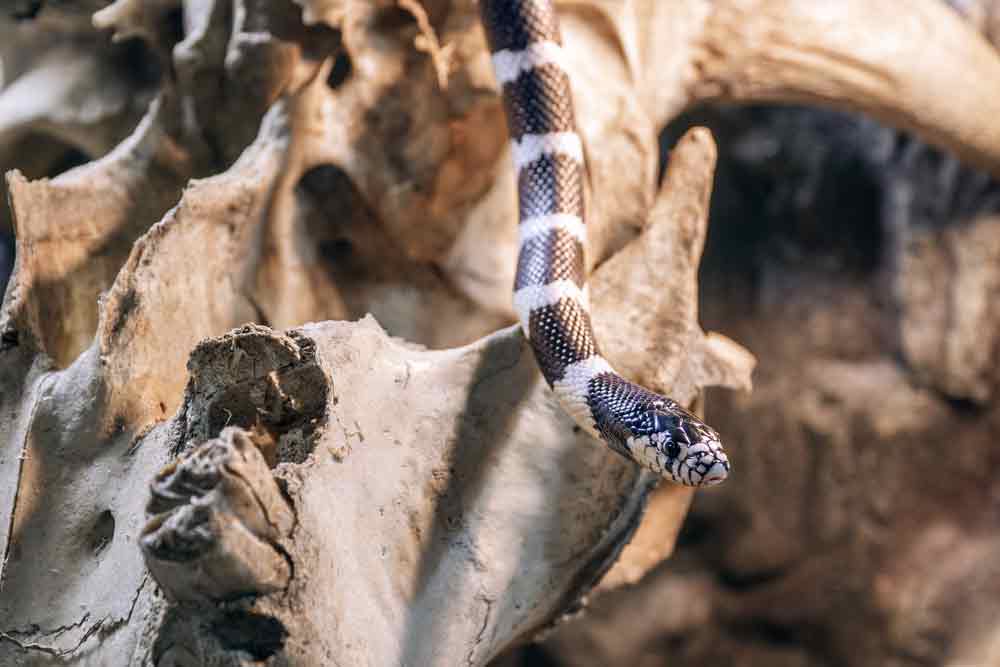
California kingsnake on wood. Ensure your enclosure has some nice pieces of wood for your kingsnake to climb and explore. Photo by Andreas Wolochow/Shutterstock
The Importance of Handling Your California Kingsnake
The California kingsnake is known by some to be a bitey snake. Your results will vary with your indivudal snake. As with all snakes, there is the chance your snake will bite you at some point. My California kingsnake seems to be more bitey than my other species, especially when it was younger. While it is already 10 years old, I still handle him with care to avoid the pin pricks. It is highly recommended that you correctly handle (let the snake crawl hand over hand) your California kingsnake regularly, and especially when it is younger. Your snake will for the most part enjoy the interaction. Fifteen minutes a few times a week ideal. Reduce the handling of your snake when it is in shed. After it has shed its skin, you can resume your regularly scheduled handling.
Conclusion
In my opinion, the California kingsnake is one of the best choices among any level of reptile keeper. They are widely available, and for those looking for something different, are available in a variety of morphs and color patterns. They are one of the oldest species in the reptile hobby and are a hardy snake. They are by no means a delicate species, and will let you know when it is not happy for no reason at all. The California kingsnake would make an ideal second snake, for those who have experience with other neat species, such as the corn snake, or if you have more experience with other reptiles, it would make an ideal first snake. Just ensure your enclosure is escape proof!

